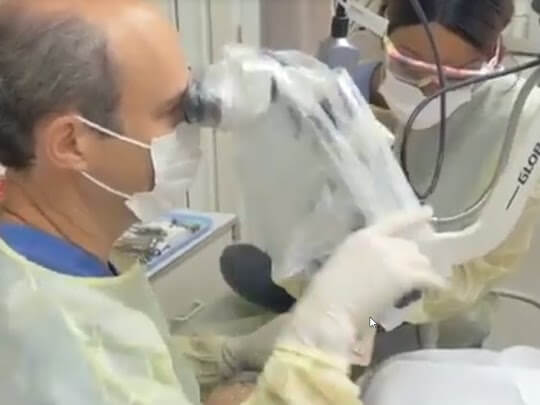Do some of your teeth have less gum tissue than they should due to gum recession? You may need gum grafting when the roots of your teeth are beginning to be exposed. As your gums recede you may experience temperature sensitivity and even risk the possibility of eventually losing teeth. This condition can happen at a relatively young age. According to the CDC, in the USA 47.2% of adults aged 30 years and older have some form of periodontal disease, and, unfortunately, this percentage increases with age. In fact, it’s been reported that a surprising 70.1% of adults 65 years and older have periodontal disease.
The Stages of Gum Disease
The early stage of gum disease is called gingivitis, which is characterized by bleeding when brushing, swollen gums that may have changed from a healthy pink to a reddish hue. In its more serious form, it is called periodontitis. At this stage, your gums begin to separate from your teeth, forming pockets (spaces between the teeth and gums) that can become infected. Unfortunately, as the disease progresses, the pockets deepen and more gum tissue and bone are destroyed.
The Solutions for Gum Recession
Scaling and Root Planing
One of the solutions for gum recession, when it has not advanced to a greater degree, is a two-part procedure called scaling and root planing. This is a non-surgical procedure to treat gum disease and stop it at the gingivitis stage. Dr. Kissel performs this procedure at his Manhattan, New York City periodontal office, where you will be offered anesthesia to numb your gums and teeth. Dr. Kisser is one of the few periodontists who use the Perioscope (a powerful microscope) to conduct scaling and root planing. Using the Perioscope, he is able to clearly see any tartar you may have directly on the root of the affected tooth in large detail. He can then precisely and proficiently remove the tartar in a more efficient and thorough manner. This treatment can help your gums reattach to your teeth.
Gum Surgery or Gum Grafting
If your gum disease has progressed to the stage of periodontitis, treating your receding gums may require gum surgery or gum grafting. Dr. Kissel uses microsurgery techniques to provide a minimally invasive surgery and faster recovery. He performs the gum draft by removing small pieces of tissue from the roof of your mouth utilizing microsurgery techniques. By treating and preventing receding gums, you minimize the possibility of bacteria overgrowth, which can cause serious issues such as bacteria invasion, erosion, tooth decay, and tooth loss. However, gum grafting not only prevents further gum loss and bone tissue loss but also provides cosmetic benefits. For example, your teeth will look much more attractive since your gum grafts will reduce the gray coloring of the gums, cover up crown margins, and thicken up the gum tissue that surrounds dental implants or crowns.
Why Use Microsurgery for Gum Grafting
One of the reasons Dr. Kissel’s treatments stand out is the fact that he has been performing them using microsurgery techniques. With over 25 years of experience, he is able to perform the procedure with extreme precision thanks to his microscope which is able to magnify an image (24-48x) on a video screen. He insists on conducting gum grafting surgeries using microsurgery because, as we have mentioned, it is minimally invasive and, as a result, less painful. The time needed to complete the procedure depends on the number of grafts – it normally takes about one hour to graft each tooth.
Microsurgery patients tend to heal much faster and without complications compared to patients who use traditional surgical instruments and techniques. Additionally, one of the most significant benefits of performing gum grafting using microsurgery is the fact that it significantly reduces the risk of complications. This is because the better your dental surgeon can see, the more knowledge he or she can acquire resulting in careful manipulation of tissues and critical anatomy. Studies have shown that when a surgical microscope is used, the complete root coverage achieved was significantly higher than when gum grafting was performed without it.
After the Procedure
Once the procedure is completed, Dr. Kissel uses are clear stitches that almost invisible to suture the graft. Moreover, with microsurgery, you will not require surgical dressing. The greatest inconvenience reported by gum grafting patients is not being able to chew at the surgical site for six to eight weeks after the procedure.
If you have receding gums, contact Dr. Kissel to book your consultation online or by calling his Manhattan periodontal office at 212-702-9088. Learn more about his training and experience in performing gum grafting using microsurgical techniques and how he can treat your receding gums with minimal discomfort. Dr. Kissel will develop a personalized gum disease treatment program to save your teeth and help you reclaim your beautiful smile.
